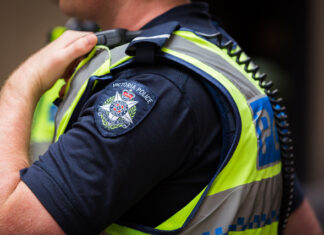 Third eye: The Tucker features the Cyclops Eye mounted in the middle front which turns on at a steering angle greater than 10 degrees to light the car’s path around corners.
Third eye: The Tucker features the Cyclops Eye mounted in the middle front which turns on at a steering angle greater than 10 degrees to light the car’s path around corners.
Greg Wane
THE STAR at the recent Motorclassica event at Melbourne’s Exhibition Building in was a 1948 Tucker sedan, estimated to be worth more than $1 million.
Initially named the Tucker Torpedo it was an advanced car conceived by American businessman Preston Tucker in 1948.
Only 51 cars were built before the company folded on March 3, 1949, when Tucker was brought undone by legal and financial battles.
His cars have since become legendary.
Tucker, a flamboyant carmaker had grand dreams in the heady years after the end of the Second World War.
During this period, the public was ready for totally new car designs, but the big three Detroit carmakers had not developed any new models since 1941. This provided opportunities for small, new carmakers who could develop cars more rapidly.
Studebaker was the first to introduce an all-new postwar model, but Tucker took a different tack, adding safety to his design brief plus adding as many innovative features as his engineers could come up with, and a modern styling.
His specifications called for a water-cooled aluminium block, flat six rear engine, disc brakes, four-wheel independent suspension, fuel injection, the location of all instruments on the steering wheel, and a padded dashboard.
Tucker’s first design for the car appeared in a 1946 Science Illustrated magazine and he called it the “Tucker Torpedo”.
The ‘torpedo’ was later dropped after it reminded too many people of the horrors of the recent world war. The car was re named the Tucker ‘48.
Many components and features of the car were innovative and far ahead of their time. The most recognisable feature of the Tucker ’48, a directional third headlight, known as the Cyclops Eye, which would turn on at steering angles of greater than 10 degrees to light the car’s path around corners.
A perimeter frame surrounded the vehicle for crash protection, as well as a roll bar integrated into the roof.
The steering box was behind the front axle to protect the driver in a front-end accident.
The instrument panel and all controls were in easy reach of the steering wheel, and the dash was padded for safety.
The windshield was designed to pop-out in a collision to protect occupants. The car also featured seat belts, a safety feature not introduced until the early 1960s in Australia.
The car’s parking brake had a separate key so it could be locked in place to prevent theft.
Tucker envisioned several other innovations which were later abandoned, including magnesium wheels, disc brakes, fuel injection, self-sealing tubeless tires, and a direct-drive torque converter transmission were all evaluated and/or tested but were dropped on the final prototype due to cost, engineering complexity and lack of time to develop.
The Tucker was powered by a rear mounted Bell helicopter engine, giving the car a top speed of 190 km/h, very fast for 1948. The rear-wheel-drive car weighed almost two tonnes
The company first tried the Lycoming aircraft engine but it would not fit in the car’s rear engine compartment.
A Franklin air-cooled flat-six engine, the O-335 made by Air Cooled Motors and originally intended for the Bell 47 helicopter, fit into the engine bay and with its 124 kW it pleased Tucker.
His engineers converted the 5.5 litre engine to water cooling.
Using an aircraft engine in an automobile application required significant modification. This durable modification of the engine was tested at maximum power for 150 hours, the equivalent of 18,000 miles at full throttle.
Tucker bought Air Cooled Motors company for $1.8 million to secure his engine source, then cancelled all of the company’s aircraft contracts so that the workforce could work exclusively on making automotive engines for the Tucker Corporation.
To prove the road-worthiness of his cars, Tucker and his engineers ran several cars at the Indianapolis Motor Speedway in several endurance tests.
During this testing, car number 1027 was rolled at high speed while driven by mechanic Eddie Offut. The car’s safety features were proven when Offut walked away from the severe crash.
During the crash, the windshield popped out as designed, and afterward the car started up and was driven off the track.
Fifty-eight frames and bodies were built at the Chicago factory. From these parts, 36 sedans were finished before the factory was closed.
After the factory closed but before liquidation of his assets, Tucker retained a core of employees who assembled an additional 14 sedans for a total of 50. A 51st car was partially completed.
According to Tucker enthusiasts, when the cars appear at auction, which is rare, they command very high prices. Tucker number 1038 sold in August 2008 at an auction in the United States for the record-setting price of $1,017,500.
In August 2010 at RM’s Monterey auction, Tucker number 1045 sold to a Melbourne businessman for the record-breaking price of $1,127,500.
The car arrived in Melbourne last month in time to join more than 80 other classic cars that were driven through Melbourne as part of the Tour Classica prelude to Motorclassica.






